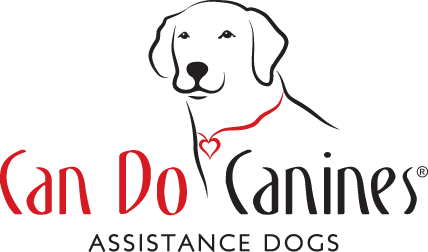“Yes” tells our dogs that they’ve done the correct behavior and that they’ve earned a treat. We time our “Yes” to when our dog is doing the desired behavior, so they pair that action with the reward. For example, when a dog sits, we say “Yes” when their backside touches the floor, then give them a treat. Pretty soon, the dog is convinced they have a magical booty that summons cookies when pressed to the ground! The secret to dog training is that dogs are greedy: They do what pays best! Clearly communicating with our dogs which behaviors are profitable …
Puppy Program – 2025 Volunteer Summit Presentations Co-Raising, How does it work? Medical Care for a Can Do Canine (click here for a link to Illness & Injury Reference Guide) A Day In The Life of a Dog in Final Training Shaping Training Relaxed Dogs and The Important Skill of “Doing Nothing” Prison Program Presentation
Hot Pavement It is important to check how hot the pavement is before walking the dog on it. With sun, darker surface temperatures can reach double outside temps! If you utilize enclosed tennis courts for exercising the dog, please keep in mind that this surface can also get very hot. Follow these guidelines to determine safe use: Use the back of your hand and hold it on the pavement. Count to 7. If you can hold the back of your hand on the pavement, it is safe for the dog. If you cannot hold your hand on the pavement, it …
As a reminder, the only foods and supplements that our puppy program dogs should receive are their designated kibble diet and a small amount of peanut butter or non-fat plain yogurt in a Kong. These are the only two items that should be part of their regular diet unless we’ve provided explicit directions to do something different. Any changes outside of these guidelines can affect the dog’s health, and it’s essential that we stay informed about any modifications, as these dogs are closely monitored and cared for by multiple teams throughout their training journey. Scenario 1: Imagine your puppy starts …
Event Schedule When: Saturday, May 3 Where: Can Do Canines facility, New Hope, MN Who Can Attend: Active Puppy Program Volunteer Hosts Registration Deadline: Tuesday, April 15 **Please note: If you would like to attend both sessions – you will need to register for each session individually.** Morning Schedule: Click Here To Register 8:30 – 9:00 a.m. – Check-In 9:00 – 9:15 a.m. – Welcome 9:15 – 9:45 a.m. – Co-Raising, How does it work? 10:00 – 10:45 a.m. – Medical Care for a Can Do Canine 11:00 – 11:45 a.m. – A Day In The Life Of A Dog In Final Training 12:00 …
Consistency is Key Service dogs work with multiple trainers and handlers before they are placed with their eventual partner. Program standards ensure that all individuals involved in the dog’s training use the same techniques, tools, and approaches. This consistency prevents confusion for the dog, making their learning process smoother and more effective. For example, using the same verbal cues and training methods helps the dog understand expectations, which in turn builds confidence and reliability. Safety Comes First The physical and emotional health of service dogs is a top priority. Program standards are designed to protect dogs and the people working with them. …
Outside Guidelines General rule of thumb: If it’s too cold for you, it’s too cold for them. Dogs can get frostbite too. Please keep them indoors during inclimate weather conditions. Keep walks short, but try to provide them more frequently so they still get proper exercise. See if there are indoor tracks or facilities near you where you could walk the dog for exercise. Musher’s Secret is a good option to use on the dog’s pads for cold-weather walking. If you’ve walked the dog on surfaces that have been salted for ice, wipe their paws and in between toes upon …
Our main consideration when teaching the dog how to move through narrow spaces is how a client might face this situation. We always want the dog to remain at the handler’s side and in view of the handler. We do not want the dog to practice switching sides behind the handler. This can cause the leash to become tangled (think: client using a wheelchair or walking device) or hard to hold on to, and can also create a tripping hazard. If the dog needs to be moved to a different side, it should move in front of the handler (always …
What is a Slow-Feed Bowl, and How Do They Work? Slow-feed bowls are specially designed feeding dishes that feature obstacles-such as raised ridges, grooves, or mazes-that require dogs to navigate around them to access their food. These clever designs slow down a dog’s eating pace, promoting healthier digestion. Unlike traditional bowls that allow for quick consumption, slow feeders encourage dogs to take their time at mealtime. Why We Might Need to Use Them Many dogs eat too quickly, leading to digestive issues like bloating, choking, or vomiting. Rapid eating can prevent proper digestion and absorption of nutrients, creating long-term health …
Written by Vanessa Williams, Wild Goose Chase, November 2022 Let’s talk about puppy focus and how much this specific stage of life (pre-adolescence) is the absolute worst. Puppies are toddlers and then they go right into teenagers. Anyone raising human kids knows that both toddlers and teenagers lack focus in their lives. Hormones, teething, brain development, etc. all impact our puppy’s ability to focus on tasks, training, behaving, listening. And just like human toddlers and teenagers, many times this makes them extremely ego-centric. This isn’t to say that they are selfish, per say, but more so that they are biologically …




